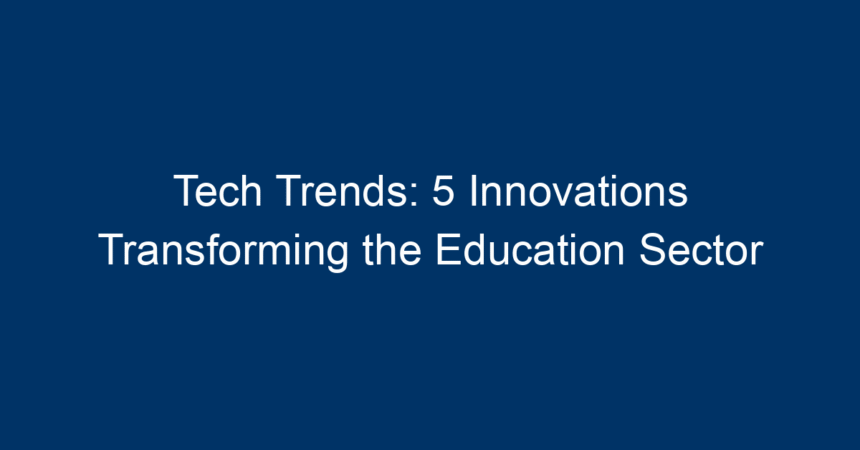In a rapidly evolving world, technology significantly reshapes various sectors, and education is no exception. As traditional classrooms give way to digital learning environments, innovative tech trends have emerged that promise to revolutionize how we teach, learn, and engage with academic content. In this article, we will explore five key innovations that are currently transforming the education sector and their implications for educators and students alike.
1. Artificial Intelligence (AI) in Education
Personalized Learning Experiences
One of the most significant tech trends in education is the adoption of Artificial Intelligence (AI). AI-powered tools are increasingly being used to create personalized learning experiences tailored to the unique needs of each student. These technologies analyze data to identify individual strengths, weaknesses, and learning styles, enabling educators to provide targeted support.
For instance, platforms like DreamBox Learning and Knewton use AI algorithms to adjust the difficulty level of activities based on a student’s performance, ensuring that they remain engaged without feeling overwhelmed. This kind of adaptive learning not only enhances the educational experience but also helps educators track progress more effectively.
Chatbots and Virtual Assistants
AI isn’t limited to personalized learning. Chatbots and virtual assistants are becoming common in educational institutions. These tools can help students with queries regarding coursework, schedules, and even administrative processes. Institutions like Georgia State University have implemented AI-driven chatbots to address student inquiries and reduce the burden on administrative staff, leading to streamlined operations.
2. Virtual and Augmented Reality (VR and AR)
Immersive Learning Experiences
Virtual Reality (VR) and Augmented Reality (AR) are tech trends that are creating immersive learning environments. These technologies provide students with opportunities to engage with content in ways that were previously unimaginable. For example, VR can transport students to ancient civilizations, allowing them to explore historical contexts, while AR can overlay additional information on physical objects during science experiments.
Companies like Oculus and Google Expeditions are paving the way for this revolutionary approach. Studies have shown that learning through immersive experiences can enhance retention and understanding, making these technologies a valuable tool for educators.
Real-World Applications
Moreover, VR and AR are also finding applications in vocational training. For instance, medical students can practice surgery in a risk-free environment using VR simulations, greatly enhancing their skills and confidence. Similarly, engineering students can use AR to visualize complex structures before construction, bridging the gap between theory and practice.
3. Learning Management Systems (LMS)
Streamlined Learning Environments
Learning Management Systems (LMS) are another vital tech trend contributing to the transformation of education. These platforms centralize course materials, assessments, and communication between students and educators. Popular LMS platforms, such as Moodle, Canvas, and Google Classroom, have made it easier for teachers to deliver courses and monitor student progress, even in remote learning settings.
Flexibility and Accessibility
The shift towards online learning has also highlighted the importance of accessibility. LMS platforms are designed with usability in mind, offering features like mobile access, screen reader support, and multilingual options to ensure that all students can engage with their learning materials. This greater accessibility fosters inclusivity, providing educational opportunities for a wider audience.
4. Gamification in Learning
Engaging Students through Play
Gamification is one of the most exciting tech trends in education, as it leverages game mechanics to foster engagement and motivation in students. By incorporating elements like points, badges, and leaderboards into educational activities, teachers can transform mundane tasks into interactive challenges that capture students’ attention.
Platforms like Kahoot! and Classcraft exemplify this approach, where quizzes and assignments become competitive games. Studies show that gamification in education can improve motivation and even enhance learning outcomes, making it a valuable strategy for educators.
Building Essential Skills
Furthermore, gamification extends beyond just fun. It can help develop critical skills such as problem-solving, collaboration, and time management. By working through challenges in a game-like setting, students can cultivate these skills in a low-stakes environment, preparing them for future academic and professional experiences.
5. The Internet of Things (IoT) in Education
Smart Classrooms
The Internet of Things (IoT) represents a tech trend that is enhancing the educational landscape. Smart classrooms equipped with IoT devices offer a more interactive and engaging learning experience. From smart boards to connected devices, these technologies facilitate real-time collaboration and communication among students and teachers.
Data-Driven Decision Making
IoT can also collect valuable data on student performance and engagement, allowing educators to make data-driven decisions. For example, smart attendance systems can alert teachers if a student consistently misses classes, prompting timely interventions. This ability to gather and analyze data in real-time ensures that educators can tailor their approaches to meet the diverse needs of their students.
Conclusion: Embracing Tech Trends for Future Education
The future of education is undoubtedly intertwined with technology. As we have explored, innovations such as AI, VR/AR, Learning Management Systems, gamification, and IoT are transforming the educational landscape, making learning more engaging, personalized, and accessible.
Actionable Insights
-
Stay Informed: Educators should continually explore new tech trends and integrate them into their teaching practices to enhance learning outcomes.
-
Invest in Training: Institutions must invest in training for educators to effectively use these technologies, ensuring that everyone can maximize their benefits.
-
Focus on Accessibility: In implementing new technologies, prioritize accessibility to create inclusive learning environments for all students.
-
Encourage Collaboration: Foster a collaborative culture where students can share their experiences and insights regarding the use of technology in education.
- Monitor and Evaluate: Regularly assess the effectiveness of tech implementations to make data-driven improvements that benefit student learning.
Embracing these tech trends can help educators create a dynamic, engaging, and effective learning environment that meets the needs of today’s diverse student population. In the end, the goal is not just to incorporate technology for technology’s sake but to enhance the educational experience and prepare students for a brighter, more technologically advanced future.




